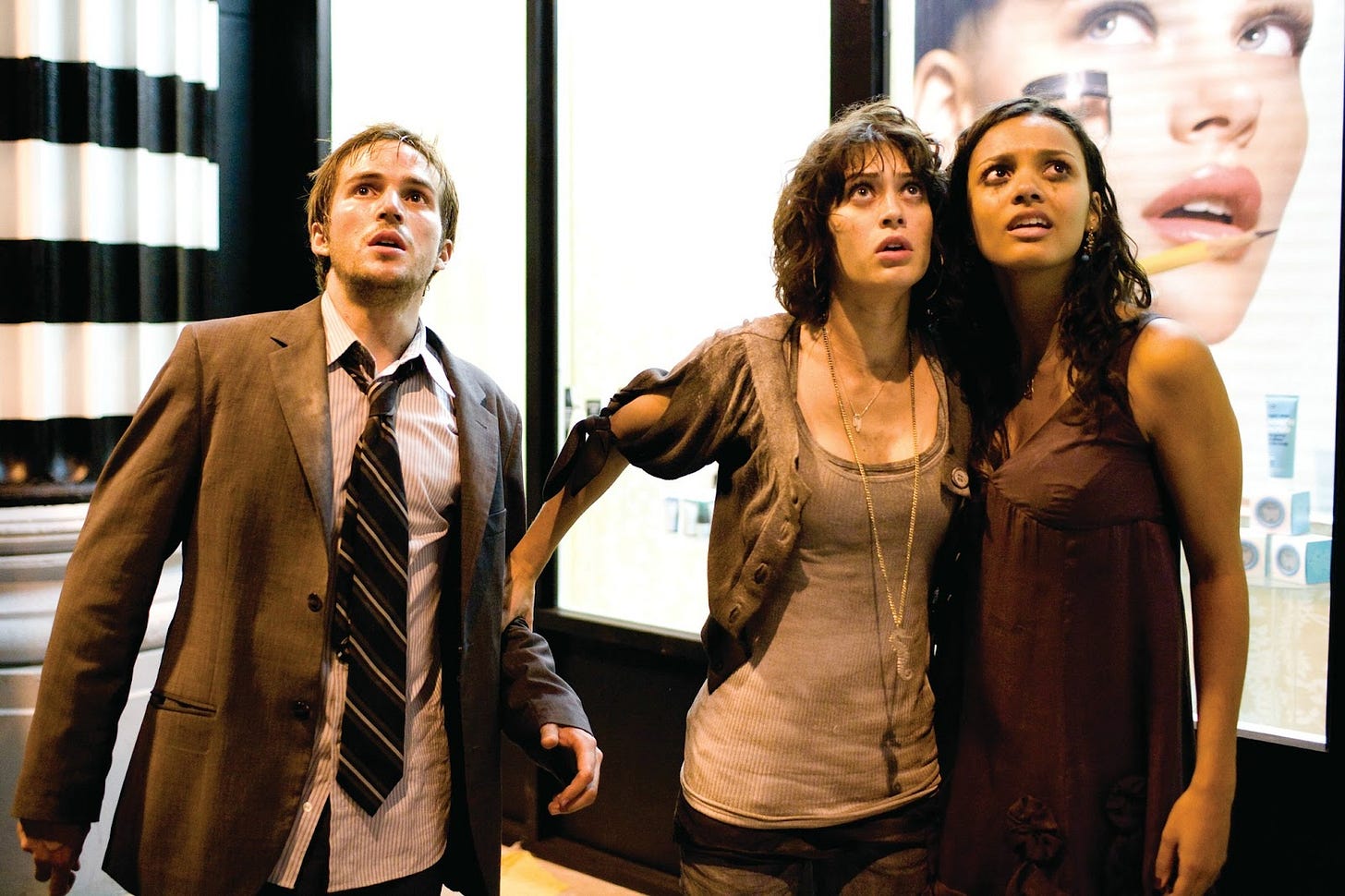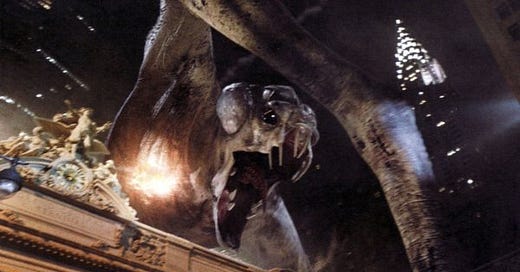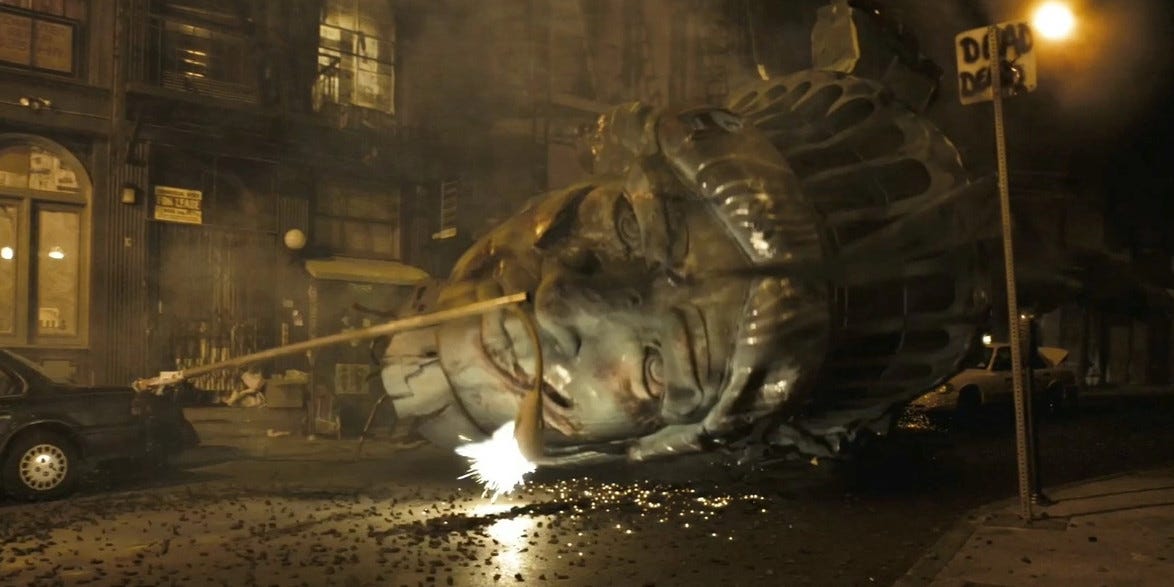"It's Alive": Why 'Cloverfield' Seems Real
The monster film becomes something more by using found-footage and a unique approach to special effects.
Author’s note: this article is based on a film criticism paper I wrote for my Contemporary Cinema course at Virginia Tech. It has been edited for clarity and conciseness.
A blast in the distance; the unknown lurks around the street’s corner; utter chaos through the literal lens of a bystander. Cloverfield (2008) dir. Matt Reeves is not just a monster film starring a creature à la Godzilla and King Kong. It is a technical experiment that implements our real fears into the fantastical. Cloverfield follows a group of friends who suddenly find themselves in the path of a monster rampaging through Manhattan. Released seven years after the September 11 attacks, the film is reminiscent of the anxiety of innocent civilians who happened to bring a camera that day. Cloverfield features an ensemble cast comprising Lizzy Caplan, Jessica Lucas, T.J. Miller, Michael Stahl-David, Mike Vogel, Odette Annable, and Ben Feldman. Using the found footage technique and special effects, Cloverfield turns a classic genre story into a film that seems real – too real.
Cloverfield uses a handheld camera, held by Hudson “Hud” Platt (T.J. Miller) for most of the film, to tell its story. The film starts at a going-away party for Rob Hawkins (Michael Stahl-David) before he starts his new job in Japan. Hud films the party for Rob and as an excuse to talk to his crush, Marlena Diamond (Lizzy Caplan). The party is crashed by an unknown disturbance – later learned to be a giant monster. Rob, Hud, and their friends find themselves on the streets of Manhattan, trying to survive the creature’s rampage. Hud’s camera now acts as a vessel for the group’s live reactions.
Cloverfield’s found-footage format allows the film to go beyond the archetypal monster film. Rather than use the artificial sublime like most genre films, Cloverfield utilizes the exact opposite; it takes advantage of both the characters and the audience’s lack of knowledge. Since the film is told entirely through the lens of Hud’s camera, we do not fully see the monster until the third act. Until then, we are given crumbs of a mysterious disturbance and brief glimpses at an unknown anomaly the size of Manhattan’s skyscrapers. The plot of Cloverfield is strictly limited to the contents of a random digital SD card found in Central Park, so there is potentially more to the story than what we know. Reeves’ relocation of cinema introduces a unique perspective to chaos cinema. This relocation of cinema creates a new terrain that proves to be productive for film. In particular, Cloverfield defines found footage as a versatile technique for any film, not just low-budget horror.

Whereas the found footage technique in Cloverfield revolutionized chaos cinema, the film’s usage of special effects revolutionized found footage. Despite the challenges of shaky camerawork and Reeves’ precise direction, the visual effects in Cloverfield appear legitimate and straight out of a camera’s archive. The film uses blurry, out-of-focus shots and Reeves' direction to make the special effects seem realistic. Because the film is seen through Hud’s camera, the explosions and the monster are designed from the device’s perspective. The special effects prioritize the camera’s point-of-view rather than the acute details of what is occurring. For example, when Rob and his friends evacuate his apartment building after the first of several explosions, a blurry unknown object flies through the street. The object crashes onto the pavement and Hud impulsively moves the camera down. When the object lands and Hud moves the camera toward the object, we see it is the head of the Statue of Liberty. The VFX is fully detailed once the object is revealed to be the decapitated Lady Liberty. Before its reveal, the special effects utilize the camera’s lack of focus and Reeves’ direction to conceal the object. The special effects use the characters’ points of view to their advantage by hiding the littlest details, allowing the audience to view the incident as if they are on the ground too.
Implementing the special effects into the film was not an easy job, however. Cloverfield’s shaky camerawork was a hurdle for VFX artists working on the film. Despite their concern about designing special effects without the use of still imagery, Reeves was adamant about making the camerawork as realistic as possible. In a retrospective interview, Reeves stated:
...At the time, the VFX people were saying, “I think you’ve got to shoot it on steady cam, and we’ll add the shake later.” And I was like, “That’s never going to work. The audience is going to know, it’s going to look totally inauthentic. That’s terrible.” I was like, “We have to do this handheld.”
Cloverfield is not just a monster movie predicated to be a box-office hit by studio executives. The film is a radical experiment in found footage. It is a form of perception and material perceived by a new audience – one willing to encounter new reality and whatever parts of reality are discovered. The film takes a low-budget, indie film technique and applies it to chaos cinema. As a result, Cloverfield becomes a film that could be real despite its make-believe premise. The film’s utilization of special effects implemented into shaky camerawork emphasizes the limited point-of-view. Cloverfield proves that cinema can terrify audiences not just by what they cannot see, but by the frustration of what they can only see.



